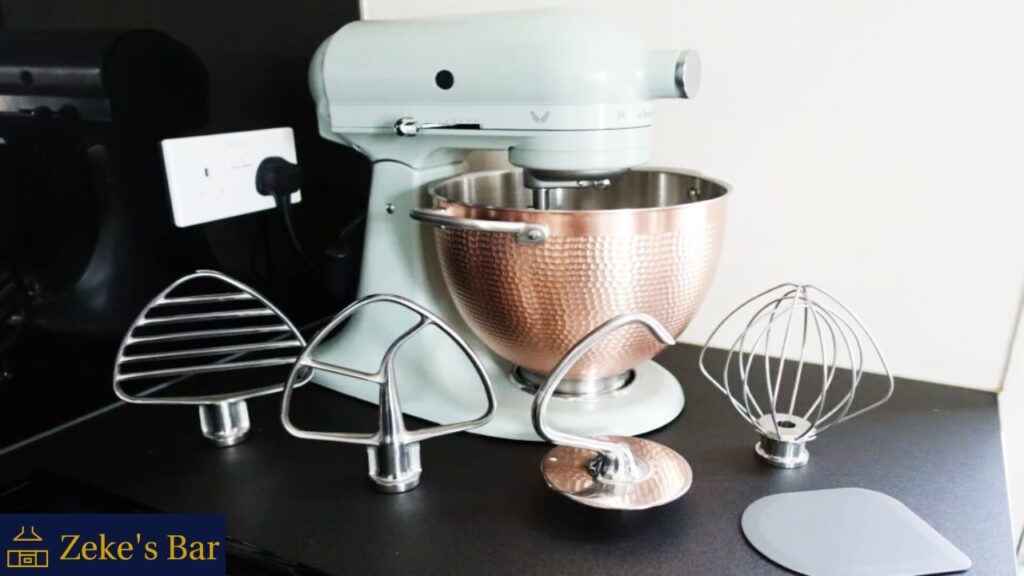Can a KitchenAid Mixer Bowl Go in the Dishwasher?
If you’re one of the many people who own a KitchenAid mixer, you’ve likely wondered, “Can a KitchenAid mixer bowl go in the dishwasher?” This is a common question, and the answer varies depending on the material of your bowl. Let’s break it down.

What is a KitchenAid Mixer Bowl Made Of?
KitchenAid mixer bowls come in different materials, and knowing which one you have is essential for deciding whether it’s dishwasher-safe.
Stainless Steel Bowls
Stainless steel is a durable, rust-resistant material, making it a popular choice for KitchenAid mixer bowls. These bowls are perfect for heavy-duty mixing and can withstand high temperatures.
Glass Bowls
Glass bowls are another option and offer the benefit of being microwave-safe. They’re ideal for recipes requiring a precise view of the mixing process.
Ceramic Bowls
Ceramic bowls are both beautiful and functional. They are often favored for their aesthetic appeal, and some models come with decorative designs that can add flair to your kitchen.
Are KitchenAid Mixer Bowls Dishwasher Safe?
Whether your KitchenAid mixer bowl is dishwasher-safe depends entirely on its material and the manufacturer’s recommendations. Let’s dive into each material to explore its compatibility with dishwashers.
Can You Put a Stainless Steel KitchenAid Mixer Bowl in the Dishwasher?
Yes, most KitchenAid stainless steel mixer bowls are dishwasher safe. They’re designed to handle the heat and pressure of dishwasher cycles without suffering damage.
However, frequent dishwasher use may dull the polished finish of your bowl over time. To preserve its shiny appearance, you might want to hand wash it occasionally. Avoid using harsh detergents, as they can cause pitting or discoloration in stainless steel over time.
Can You Put a Glass KitchenAid Mixer Bowl in the Dishwasher?
Yes, KitchenAid glass bowls are generally dishwasher-safe. Glass is sturdy, and many KitchenAid glass bowls are designed to handle the heat and water pressure of a dishwasher.
However, be cautious. Even though glass is durable, it’s still prone to cracking or chipping if the bowl is placed too close to other dishes or if the dishwasher is overcrowded. To avoid accidental breakage, ensure there’s enough space around the bowl in the dishwasher.
Can You Put a Ceramic KitchenAid Mixer Bowl in the Dishwasher?
While KitchenAid ceramic bowls are also labeled as dishwasher-safe, they can be more susceptible to damage than stainless steel or glass bowls. The decorative designs on some ceramic bowls can fade after prolonged exposure to hot water and detergents. Also, sudden temperature changes in the dishwasher may cause cracks or crazing in the ceramic.
To maintain your ceramic KitchenAid bowl’s beauty, hand washing with warm water and mild detergent is often recommended.
How to Properly Clean a KitchenAid Mixer Bowl
Regardless of whether you use a dishwasher or hand-wash your mixer bowl, it’s essential to clean it properly after every use. Here’s how:
Stainless Steel: Use mild dish soap and a non-abrasive sponge. If hand-washing, dry it immediately to prevent water spots.
Glass: Glass bowls can be washed with warm water and detergent. Avoid abrupt temperature changes to prevent cracking.
Ceramic: Hand wash with a soft sponge and mild soap to protect the glaze and designs.
Dishwasher-Safe Attachments and Accessories
While the mixer bowl is a focus, you might wonder about other parts of your KitchenAid mixer. Good news! Many KitchenAid mixer attachments, such as the dough hook and flat beater, are also dishwasher-safe. However, always check the product manual for each specific accessory, as some may require hand-washing.
How Dishwashers Can Affect Different Materials
Dishwashers are convenient but can be harsh on different materials. Detergents contain chemicals that might corrode metals, dull finishes, or leave residue on glass and ceramics. High heat in the drying cycle can warp or weaken materials over time. Always be
aware of the settings on your dishwasher, and consider using gentler cycles for delicate items like glass or ceramic bowls.
Best Practices for Keeping Your KitchenAid Mixer Bowl in Great Shape
To keep your KitchenAid mixer bowl looking and performing its best, follow these simple tips:
Stainless Steel: Avoid using steel wool or abrasive cleaners to prevent scratching. Regularly polish with a stainless steel cleaner to maintain shine.
Glass: Handle with care, especially in the dishwasher. If you notice small cracks, it’s safer to replace the bowl before it breaks completely.
Ceramic: Never use harsh chemicals or abrasive tools that could damage the finish. Protect it from sudden temperature changes, and store it in a safe spot where it won’t get knocked over.
Alternatives to Dishwasher Cleaning
Not everyone is comfortable putting their mixer bowl in the dishwasher, especially if they’re concerned about potential damage. Here are some hand-washing alternatives that are just as effective:
Mild Dish Soap: Mix a few drops of mild dish soap with warm water. Use a soft sponge to scrub away residue, and dry immediately to avoid water spots.
Baking Soda Paste: For stubborn stains or stuck-on food, create a paste with baking soda and water. Gently scrub the bowl, rinse thoroughly, and dry.
Vinegar Rinse: If odors are a concern, rinse your bowl with a mixture of water and white vinegar. This natural cleaner helps eliminate smells and sanitizes the surface.
What Happens if You Accidentally Put a Non-Dishwasher-Safe Bowl in the Dishwasher?
Accidents happen! If you’ve accidentally placed a non-dishwasher-safe bowl in the dishwasher, don’t panic. Check the bowl for any visible signs of damage, like cracks, chips, or discoloration. If the bowl seems fine, continue using it, but keep an eye out for future issues.
If the bowl has suffered any noticeable damage, it’s often best to replace it. Continuing to use a compromised bowl could lead to food safety concerns or further damage to your mixer.
Common Mistakes When Cleaning a KitchenAid Mixer Bowl
Here are some common pitfalls to avoid when cleaning your KitchenAid mixer bowl:
1. Using Harsh Detergents: Strong chemicals can damage stainless steel or fade the colors of ceramic bowls.
2. Overloading the Dishwasher: Ensure your bowl has space around it to avoid scratches or chips from other dishes.
3. Ignoring Manufacturer Instructions: Always refer to your product manual to ensure you’re cleaning your mixer bowl and attachments correctly.
User Experiences and Reviews
Many KitchenAid users have shared their experiences with cleaning their mixer bowls. Most report positive results from using the dishwasher, especially with stainless steel and glass bowls. However, ceramic bowl owners often recommend hand-washing to preserve the designs and prevent cracks. Overall, the consensus is that while the dishwasher is a convenient option, hand washing may extend the lifespan of your bowl.
Read: How to Bake in Paper Loaf Pans: Mastering the Art
Conclusion
So, can a KitchenAid mixer bowl go in the dishwasher?** The answer largely depends on the material. Stainless steel and glass bowls are generally dishwasher-safe, but ceramic bowls require more care. To keep your KitchenAid mixer bowl in top condition, always follow the manufacturer’s guidelines and choose the cleaning method that works best for your specific bowl.
When in doubt, hand-washing is the safest option to ensure the longevity and appearance of your bowl.
FAQs
Can I put my KitchenAid attachments in the dishwasher?
Yes, most Kitchen Aid attachments, like the flat beater and dough hook, are dishwasher-safe. However, always check the user manual for specific instructions.
How often should I clean my Kitchen Aid mixer bowl?
You should clean your mixer bowl after every use. Regular cleaning helps prevent the build-up of residue and ensures that your bowl stays in good condition.
Is it okay to soak my KitchenAid mixer bowl?
Yes, soaking is a great way to remove stubborn food residue. Just be cautious with ceramic bowls, as long exposure to water may damage the finish.
What’s the best way to remove stains from a KitchenAid mixer bowl?
For stainless steel bowls, use a paste made from baking soda and water. For glass and ceramic bowls, a mixture of vinegar and warm water works well to remove stains.
How do I prevent odors from developing in my KitchenAid mixer bowl?
Rinse the bowl immediately after use and occasionally clean it with a vinegar and water solution to neutralize any lingering smells.
